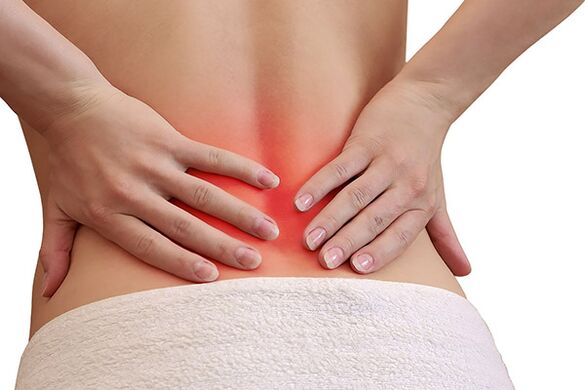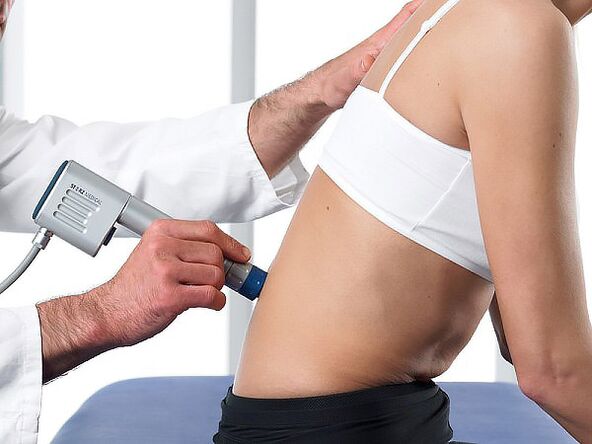Chest osteochondrosis is one of the most common diseases of the spine in humans, which damages the intervertebral discs and causes degenerative-dystrophic changes in the spine.
In osteochondrosis, the intervertebral discs lose their elasticity and fail to perform the function of shock absorption. The discs may become thinner, disintegrate and bend. The pulp nucleus shrinks and the damping function becomes impossible or reduced to a minimum, while the fibrous ring loses elasticity and gradually disintegrates, which can lead to the formation of an intervertebral hernia.
Chest osteochondrosis causes the vertebrae to move and the nerve roots to stretch, affecting the functioning of internal organs and limbs.
Because the thoracic region is less mobile in its physiological characteristics than the cervical and thoracic regions, thoracic osteochondrosis is less common.
Chest osteochondrosis mainly develops in people over the age of 40, although young people and children can also get the disease. The cause of the disease may be congenital problems of the spine or poor metabolism.
Symptoms of osteochondrosis of the thoracic spine, which are manifested at different stages of disease development. What you need to pay attention to in order to timely diagnose the disease and prescribe treatment.

Symptoms of Chest Osteochondrosis
Osteochondrosis of the chest region is often confused with other diseases, for which the pathology is called chameleon.
Chest osteochondrosis is a disease that develops slowly and at different stages there are special symptoms that you need to pay attention to in order to diagnose the disease in time and start treatment.
There are 4 stages of the disease, the symptoms of thoracic osteochondrosis vary.
1 stage
The first stage of the disease is characterized by internal cracks in the fibrous ring into which the pulp nucleus penetrates. First degree osteochondrosis can cause the following symptoms:
- Painful pain in the thoracic spine. This is the first sign that changes are taking place in the body. In osteochondrosis, pain in the chest area affects only the spine. Unpleasant pains occur after physical exertion, monotonous work or inactivity. Often patients associate such sensations with general fatigue and excessive workload, but in reality - this is the case to consult a doctor for examination;
- Muscle spasms in the heart area and slight convulsive contractions. Once the intervertebral disc begins to deform, it usually causes small nerve endings and blood vessels to stretch. This may be due to a sharp shooting pain in the chest or cramps. They pass quickly, but appear after the next load on the spine.
Stage 2
Grade 2 osteochondrosis of the thoracic region is characterized by the appearance of pathologies in the spine, which leads to excessive mobility of the vertebrae. The discs lose their former structure and shape, with each spine taking on the possibility of poorly controlled movement. This condition can cause the following symptoms:
- There are subluxations of the spine in the chest area. Subluxation is accompanied by constant pain as cold muscles. Temporarily the patient loses the ability to move fully, turning right and left;
- Pain when walking or doing anything. In osteochondrosis of the thoracic spine, the pain is exacerbated by prolonged walking or reading a book when the body is in one position.
3 stages
Grade 3 osteochondrosis causes more complex changes in the form of rupture of the fibrous ring and protrusion of the pulp nucleus, forming an intervertebral hernia. These changes cause symptoms:
- Stretched nerve roots. A hernia can lead to serious disorders of body function. It all depends on which vertebrae the ring falls between. Problems can arise in the work of the kidneys, liver, gallbladder, digestive tract. If a hernia has formed between the 1st and 2nd vertebrae of the chest region, then the hands and fingers may become resistant or even damaged.
- Spinal cord strain. Catching the spine in the spinal canal can lead to irreversible consequences leading to disability;
- Muscular tension in the chest. Abnormal processes in the spine cause constant tension in the muscles and ligaments that support the movement of the chest region;
- Development of kyphosis or scoliosis. Chest osteochondrosis can cause abnormal changes in the spine in the form of kyphosis or scoliosis. The spine can be deformed in the damaged area and become immobile.
4 stages
The symptoms of stage 4 osteochondrosis of the thoracic spine intensify, the patient may drown, be constantly depressed. The patient is constantly suffering from pain that has been bothering him for a long time. Decreased ability to work, fatigue occurs quickly after a small amount of physical activity. Stage 4 osteochondrosis of the thoracic spine causes deviations in the work of internal organs.
The symptoms of osteochondrosis are the same in men and women, because as soon as one or more manifestations of poor health or pain are observed in the chest area, it is necessary to consult a specialist.
Things can lead to the development of osteochondrosis of the thoracic spine. Which moments of human life should be paid attention to to prevent the symptoms and treatment of this dangerous disease.
Causes of osteochondrosis of the thoracic spine
The main reason for the development of pathology is the lack of physical exercise, due to which the muscles and ligaments supported in the chest are weakened and the spine experiences increased load.
But in addition to poor physical exercise, the reasons may be:
- Hereditary and congenital problems of the spine. Spine problems can be from birth. Birth trauma (difficult childbirth or medical errors) and genetic predisposition to pathology contribute to the onset of the disease. If the parents had osteochondrosis, then under favorable conditions the child may also develop the disease.
- Wrong posture. Posture monitoring is required from an early age. School-age children may be prone to scoliosis, which later progresses to osteochondrosis and other changes in the spine. Adults should also not forget the correct posture. Chest osteochondrosis develops if you do not pay attention to the position of the spine when working, walking, reading and just sitting at the computer. It is important to always have your back straight, do not lean forward or back when walking, avoid long poses in a bent position. How to maintain posture properly, you can ask by looking at training photos on online resources.
- Nerve tension. Nervous tension always has a bad effect on people’s health and can lead to serious diseases. Stressful situations can lead to muscle stiffness and poor metabolism. Therefore, it is worth reconsidering your attitude towards certain aspects of life and protecting yourself as much as possible from provocative factors.
- Traumatic injuries. Injuries to the spine and chest can lead to osteochondrosis. It is important to treat even minor injuries in a timely manner, not to allow self-medication, but always consult a specialist.
- Wearing heavy weights and high heels. It is a known fact that every centimeter of heels puts a load of 7 to 10 kilograms on the spine. If a woman already has a predisposition to spinal diseases, then high-heeled shoes should be abandoned or the wearing of such shoes should be minimized. Pregnant women are at risk because the load on the spine in the last months of pregnancy is very large and uneven. After giving birth, newborn mothers should consult a doctor and undergo a spinal examination to prevent the development of pathology in a timely manner.
- Metabolic disease. Degenerative changes in the intervertebral discs are very often caused by lack of nutrients, which is caused by disruption of metabolic processes. To normalize metabolism you should first consult a doctor and find out what is the cause of such disorders.
- Infections and hypothermia. Timely treatment of infectious diseases in the body can adversely affect not only the spine of the chest, but also the work of other vital organs. Hypothermia can cause inflammation of the nerve roots and muscles that support the secretion of the thoracic spine.

What methods are used to treat osteochondrosis of the thoracic spine. What should be done to alleviate the symptoms and treat the disease.
Treatment of osteochondrosis of the thoracic spine
Treatment of osteochondrosis of the thoracic spine should be carried out exclusively under the supervision of an experienced specialist, after a thorough examination and diagnosis of the degree of development of the disease.
Symptoms and treatment of thoracic spine osteochondrosis are determined by a neurologist, in extreme cases the treatment is joined by a surgeon and a neurosurgeon.
In order to treat the early stages of the disease more effectively and quickly, but for this you need to consult a doctor in a timely manner. It is important to understand that the longer the pathology develops, the more consequences will need to be eliminated and this will affect financial costs and treatment time.
With timely access to specialists, it is possible to prevent spinal deformity with vitamins and physical activity. To do this, the doctor will issue a special brochure, which will be shown in the photo all the exercises. It is important to take note of the photo immediately and ask your doctor all the questions about proper performance. The first session is best under the supervision of a physician.
Treatment of breast osteochondrosis with medication
First of all, after diagnosing the disease, the doctor will prescribe treatment that relieves the symptoms of chest osteochondrosis.
First the neurologist explains the pain syndrome with the help of medication, and then goes directly to treatment.
Medications used for osteochondrosis:
- Nonsteroidal anti-inflammatory drugs. With the help of anti-inflammatory drugs the pain in the chest area is relieved.
- Diuretics. Diuretics are prescribed for swelling of the nerve roots. Diuretics relieve swelling, thereby improving blood supply to the affected areas.
- Vitamins for nerve tissue nutrition.
- Chondroprotectors. With the help of chondroprotectors they try to restore the fibrous ring of the intervertebral disc.
- Antispasmodics relieve tense muscle spasm and increase mobility in the chest region, thus reducing pain syndromes.
Symptoms and treatment of osteochondrosis of the chest do not always bring a positive result, so if drug therapy has not affected you, then your doctor will suggest a surgical solution to the problem.
Physiotherapy for osteochondrosis of the chest region
Physiotherapy for osteochondrosis of the thoracic spine is an effective method of combating the disease.
This is due to the fact that during such procedures drugs are injected exclusively into the damaged areas of the spinal column.
Physiotherapy relieves pain, inflammation and tension in muscle mass and ligaments.
Physiotherapy sessions should only be conducted by an experienced physiotherapist. Properly performed procedures will bring the desired result and speed up the healing process.
Acupuncture for osteochondrosis of the thoracic spine
This Chinese method of treating many diseases is based on the insertion of special needles into the affected areas.
Through acupuncture they tone the muscles and restore them to their former functions. Needles are inserted strictly according to certain muscle growth, so you should not do this procedure at home, guided by photos or videos from the internet.
The number of procedures is determined by a specialist based on the degree of stretching of the muscle fibers. Acupuncture in a specially trained master will be painless and restore muscle tone in a short time.































